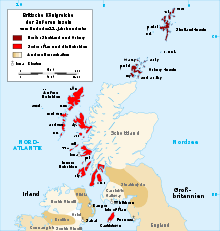Norwegian-Scottish War (1230-1231)
The Norwegian-Scottish War from 1230 to 1231 was a military conflict between Norway and Scotland over possession of the Isle of Man .
background
The Isle of Man and most of the West Scottish islands were conquered by the Vikings in the 9th century and have been under Norwegian suzerainty since the 10th century. In 1098, the Scottish King Edgar recognized Norwegian sovereignty. In the 1220s there was a power struggle between the brothers Ragnvald von Man and Olaf over control of Man . Olaf was supported by his father-in-law, the Scottish magnate Ferchar von Ross , while Ragnvald secured the support of the Scottish magnate Alan, Lord of Galloway . One of Ragnvald's daughters married Thomas of Galloway , an illegitimate son of Alan. After Ragnvald fell fighting Olaf in 1229, Alan of Galloway claimed the Isle of Man for his son Thomas.
Norwegian campaign to western Scotland
In view of the military strength of Galloway, Olaf feared an attack on Man and therefore traveled to his Norwegian overlord King Håkon IV in early 1230. He already had a smaller fleet because of the ongoing power struggles over Man and the West Scottish islands and to ward off attacks by Alan of Galloway mobilized for a campaign to western Scotland. He put Olaf and Uspak Macdougall , a nobleman from the West Scottish Islands, in charge of the campaign. The two of them led the fleet to western Scotland in the spring of 1230 and raided the islands from Skye in the north to the Kintyre peninsula in the south. Dugald Screech , a rebellious Lord of Lorn, was captured, and the Norwegians looted or raised tributes. In May 1230 they sailed into the Firth of Clyde , sacked Bute and stormed Rothesay Castle . This castle was built in the 1220s by Walter Fitzalan , who served as the representative of the Scottish King on the Firth of Clyde and was lord of Arran and Bute. When the castle was stormed, the castle commander, possibly a relative of Fitzalan's, was killed, but Macdougall was also fatally wounded. The Scottish King Alexander II moved to Ayr with an army to support Walter Fitzalan, but the Norwegians had identified Alan of Galloway as their main opponent. In view of the Norwegian threat, he had mobilized his fleet of 150 longships . The Norwegians evaded battle due to the superiority of the Galloway fleet and withdrew to Man.
consequences
Thanks to the support of the Norwegian king, Olaf was now the undisputed ruler of Man, which Alan of Galloway finally recognized. The Norwegian fleet then returned to Norway in the spring of 1231. The Norwegian king had planned to make Uspak Macdougall sub-king of the Hebrides, but after his death his brother Duncan Macdougall was declared king. Duncan was able to gain considerable influence on the West Scottish islands in the next few years.
Individual evidence
- ^ Archibald AM Duncan: Scotland. The Making of the Kingdom (The Edinburgh History of Scotland; Vol. I ). Oliver & Boyd, Edinburgh 1975. ISBN 0-05-00203-7-4 , p. 547.
- ^ Edward J. Cowan: Norwegian Sunset - Scottish Dawn: Hakon IV and Alexander III . In: Norman H. Reid (Ed.): Scotland in the Reign of Alexander III 1249-1286 . John Donald, Edinburgh 1990. ISBN 0-85976-218-1 , p. 114.
- ↑ Michael Brown: The wars of Scotland, 1214-1371 . Edinburgh University Press, Edinburgh 2004, ISBN 0-7486-1237-8 , p. 76.
- ^ Archibald AM Duncan: Scotland. The Making of the Kingdom (The Edinburgh History of Scotland; Vol. I ). Oliver & Boyd, Edinburgh 1975. ISBN 0-05-00203-7-4 , p. 548.
- ^ Archibald AM Duncan: Scotland. The Making of the Kingdom (The Edinburgh History of Scotland; Vol. I ). Oliver & Boyd, Edinburgh 1975. ISBN 0-05-00203-7-4 , p. 530.
- ↑ Michael Brown: The wars of Scotland, 1214-1371 . Edinburgh University Press, Edinburgh 2004, ISBN 0-7486-1237-8 , p. 78.
- ↑ Michael Brown: The wars of Scotland, 1214-1371 . Edinburgh University Press, Edinburgh 2004, ISBN 0-7486-1237-8 , p. 79.
